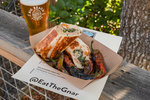Local restaurant and food truck owners have been riding the roller coaster of supply chain shortages and food cost increases. Owners say they deal with weekly and even daily changes as best they can …
This item is available in full to subscribers.
Please log in to continue |



Local restaurant and food truck owners have been riding the roller coaster of supply chain shortages and food cost increases. Owners say they deal with weekly and even daily changes as best they can while keeping their doors open.
The USDA Economic Research Services most recent Food Price Outlook for July 2022 show that the Consumer Price Index (CPI) for all food was 10.4% higher than in June 2021. Consumers are feeling that increases at the grocery store where the CPI is 12.2% higher than in June 2021. According to the same report, restaurant prices across the country are 7.7% higher than June 2021.
Many of the Baldwin County food industry owners said they have seen an increase in pricing on varying items weekly, and sometimes daily. Also, there has been a lack of availability of items their customers may not expect, like gloves, paper products and even garbage bags.
Nick Dimario, operations partner with PP Hospitality, said, "Initially it wasn't in just one area. When you have ongoing issues with gas and freight and the supply chain, it changes from week to week. One of the largest areas that has been impacted by inconsistency is the paper area of the business."
Think of how many areas in a restaurant depend on paper products. PP Hospitality brand Panini Pete's uses baskets with paper sheets to serve food, take out boxes, napkins, cash register receipts and toilet paper.
The rise in protein costs have also affected local business owners.
Divine Empanada food truck owner Aaron Penton said one of the largest price increases his business has encountered so far was for chicken. That is consistent with the USDA Economic Research Services most recent Food Price Outlook reported. Poultry prices increased 17.3% between June 2021 and June 2022 and retail egg prices are 33.1% higher than June 2021.
Tin-Tin's Rock and Roll Food Truck owner Justin Hanks said his biggest increase has been cooking oil.
"Beef and chicken have gone up a significant amount, but the cost of cooking oil has more than doubled in price," Hanks said. "Unfortunately, we had to raise prices, as much as we did not want to. Everything has doubled or tripled in price food cost wise. If not that, it is hard to get. We try not to increase too much and only as needed."
Restaurateurs must make hard decision as food prices rise. Do they increase the price of a dish, change the components or eliminate the dish all together?
Dimario and Pete Blohme with PP Hospitality said they do all the above.
"You have to be able to navigate things from a nightly sales standpoint, which is what you sell, and you have to make good decisions as it relates to placement on the menu," Dimario said. "Sometimes making a tough call."
One example of this is a menu change at PP Hospitality's property, Sunset Pointe at Fly Creek Marina.
The popular hanger steak with chimichurri sauce disappeared from the menu this summer. An increase in beef meant raising the dish's price to ridiculous levels or removing it from the menu.
Blohme and Dimario have set up systems throughout their brands that aid them in making changes. Weekly inventory lists limit what they buy and help keep track of the property it is at.
"You have to react faster than ever," Blohme said. "You can't just come up with a menu item, cost it out and just run it like we used to. Maybe every year or twice a year evaluating where you are. Now it is constant and keeping your finger on the pulse, knowing how to manipulate your menu and how to continue to provide value to your guest through proper product selection."
Blohme and Dimario are using weekly forecasting reports from suppliers to make smart choices for the products they buy as well. If Roma tomatoes are $10 cheaper a case, they will use those on paninis. If an 8-ounce filet of something is cheaper per pound than a 4-ounce filet, they will spend time cutting the meat to catch the savings.
Many restaurateurs said if sourcing is an issue, they illuminate the product temporarily. It could be as simple as not finding fresh okra to fry on the Tin-Tin's Food Truck to eliminating high-priced oysters. At the time of interview, Dimario said oysters were selling for $1 per oyster, wholesale.
"It takes some planning and preparation to be ahead of all of this, but that is just part of the formula of what we do," Dimario said. "Showing up is half the battle but having a plan is way more effective."